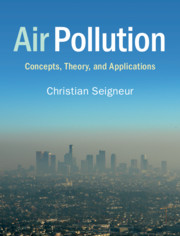Book contents
- Air Pollution
- Air Pollution
- Copyright page
- Contents
- Preface
- Main Notations
- 1 Brief History of Air Pollution
- 2 Emissions of Air Pollutants and Emission Control Technologies
- 3 Meteorology: General Circulation
- 4 Air Pollution Meteorology
- 5 Atmospheric Radiative Transfer and Visibility
- 6 Atmospheric Dispersion
- 7 The Stratospheric Ozone Layer
- 8 Gaseous Pollutants
- 9 Atmospheric Particles
- 10 Clouds and Acid Rain
- 11 Transfer of Pollutants between the Atmosphere and Surfaces
- 12 Health Effects
- 13 Environmental Impacts
- 14 Climate Change and Air Pollution
- 15 Regulations and Public Policies
- Index
- References
10 - Clouds and Acid Rain
Published online by Cambridge University Press: 19 June 2019
- Air Pollution
- Air Pollution
- Copyright page
- Contents
- Preface
- Main Notations
- 1 Brief History of Air Pollution
- 2 Emissions of Air Pollutants and Emission Control Technologies
- 3 Meteorology: General Circulation
- 4 Air Pollution Meteorology
- 5 Atmospheric Radiative Transfer and Visibility
- 6 Atmospheric Dispersion
- 7 The Stratospheric Ozone Layer
- 8 Gaseous Pollutants
- 9 Atmospheric Particles
- 10 Clouds and Acid Rain
- 11 Transfer of Pollutants between the Atmosphere and Surfaces
- 12 Health Effects
- 13 Environmental Impacts
- 14 Climate Change and Air Pollution
- 15 Regulations and Public Policies
- Index
- References
Summary
This chapter describes the processes that lead to the formation of atmospheric pollutants in clouds and fogs via aqueous chemical transformations. Although the volume occupied by water droplets in the air is small, important chemical reactions occur in clouds. These reactions modify the atmospheric chemical composition and may lead to an increase of particulate mass when clouds and fogs evaporate or to acid rain when clouds precipitate. First, some general considerations on clouds and fogs are presented. Then, aqueous chemistry is addressed. Chemical equilibria and reactions have been described in other textbooks (e.g., Stumm and Morgan, 1995), and the focus here is on the processes pertaining to air pollution. This chapter treats in particular the transformations leading to the formation of sulfuric acid and nitric acid, two constituents of acid rain (if the cloud precipitates), as well as precursors of fine inorganic particles (if the cloud evaporates). The aqueous chemistry of organic compounds concerns mostly the formation of secondary organic aerosols (SOA) and is treated in Chapter 9. Finally, emission control strategies to reduce acid rain are discussed.
- Type
- Chapter
- Information
- Air PollutionConcepts, Theory, and Applications, pp. 239 - 258Publisher: Cambridge University PressPrint publication year: 2019

